Systemic Design Club Japan
Talk
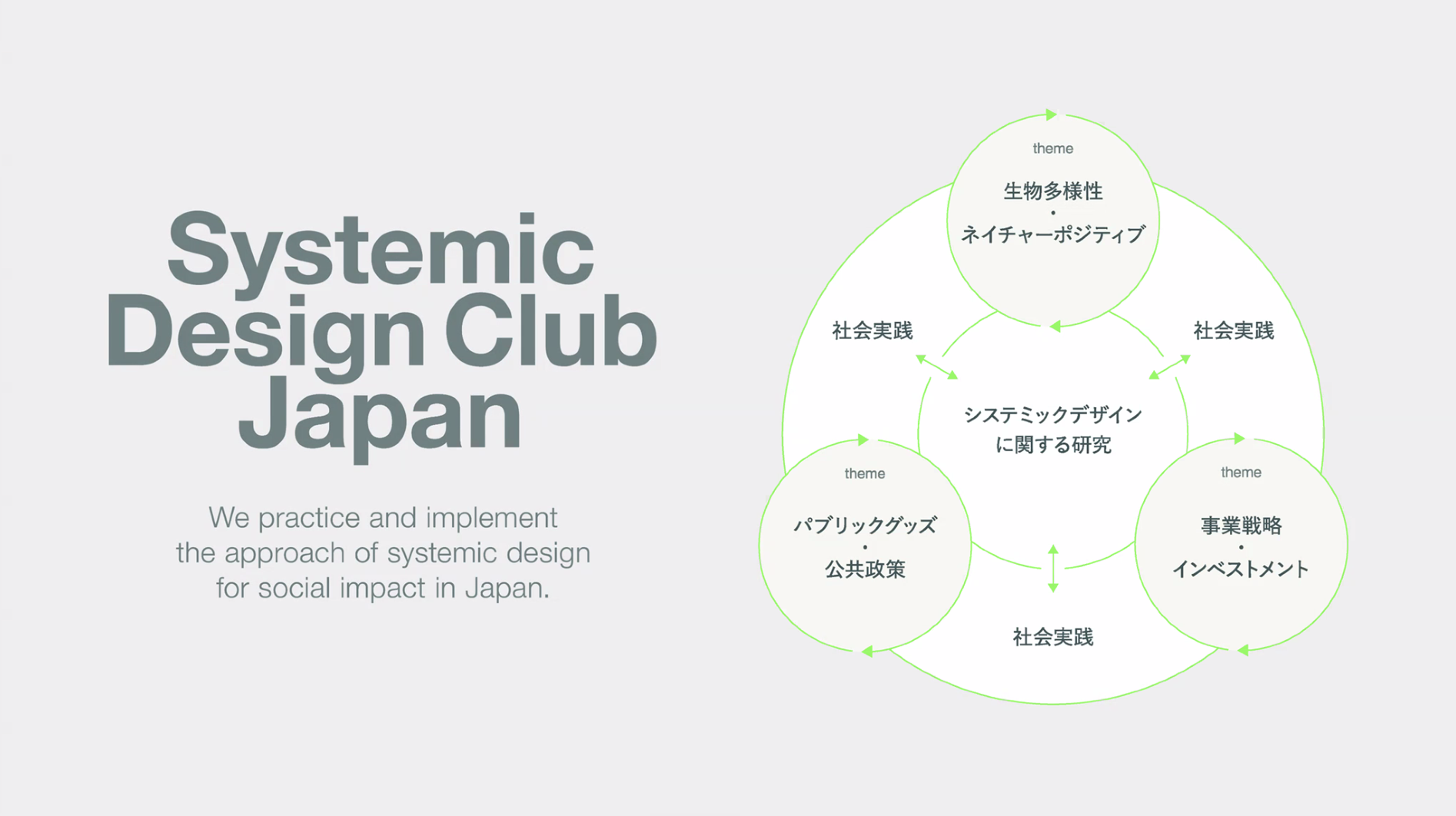
Grateful to ACTANT and Ryuichi Nambu for inviting me to speak at the Systemic Design Club Japan. Was a pleasure to engage with such a diverse group of professionals from design, policy, and finance on the topic of portfolio approach.
Below is a short summary of my presentation as well as a longer write up of the talk by the Systemic Design Club members and the full recording.
![]()
During my talk, we explored:
→ The importance of identifying the nature of the challenges we are addressing.
→ What a portfolio approach is and its usefulness in addressing complex systemic challenges.
→ Understanding the phenomena of a challenge, both pasts and presents, before designing futures.
→ Balancing work at both the conceptual and technical scales of the challenge.
→ Building new logics: not being bound by rigid structures of knowledge, but instead re-ordering information in ways that open up new ways of seeing and acting.
Below is a short summary of my presentation as well as a longer write up of the talk by the Systemic Design Club members and the full recording.
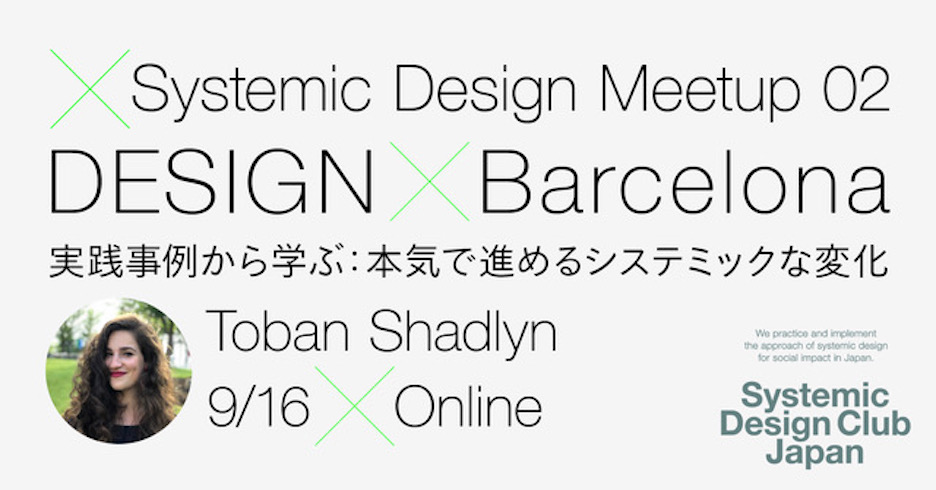
During my talk, we explored:
→ The importance of identifying the nature of the challenges we are addressing.
→ What a portfolio approach is and its usefulness in addressing complex systemic challenges.
→ Understanding the phenomena of a challenge, both pasts and presents, before designing futures.
→ Balancing work at both the conceptual and technical scales of the challenge.
→ Building new logics: not being bound by rigid structures of knowledge, but instead re-ordering information in ways that open up new ways of seeing and acting.
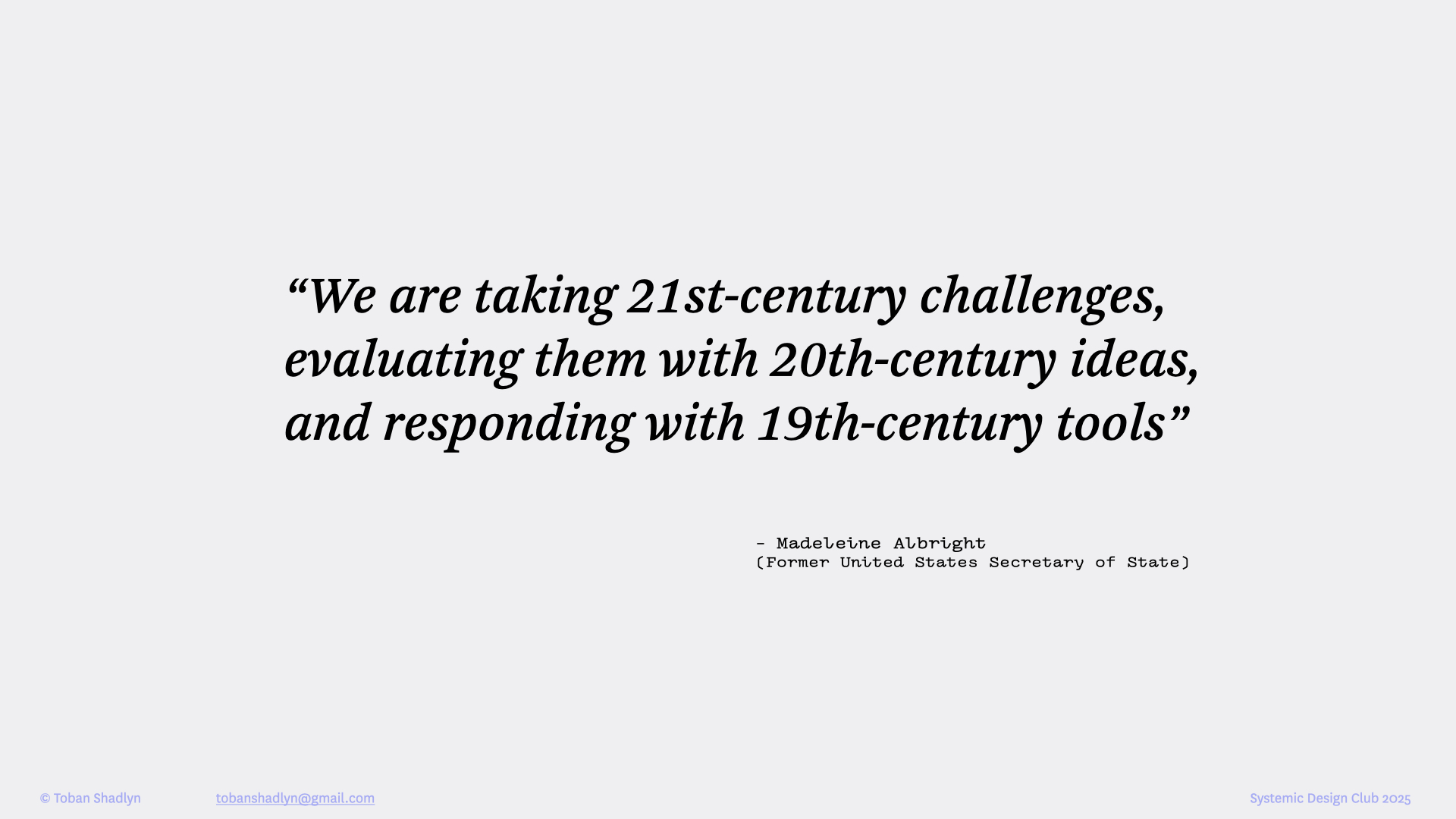
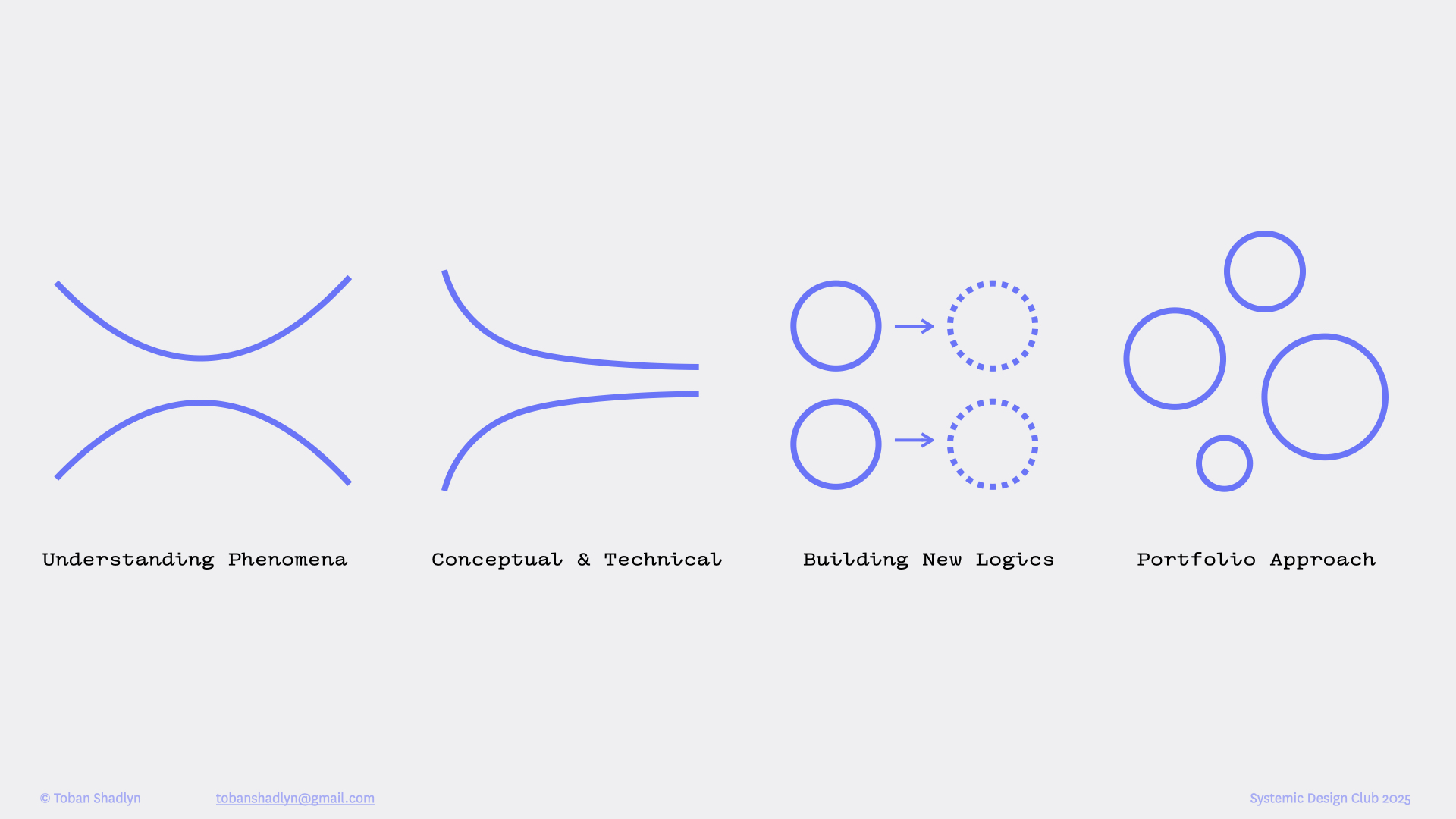
A few key takeaways:
The questions from the community were particularly revealing, highlighting the shared threads many of us are grappling with:
⦿ How do we resource and fund this way of coordinating?
⦿ How do we align on shared future directions? And what roles of orchestration are needed?
⦿ How are we designing time, navigating different time horizons, and orienting around them effectively?
⦿ What capacities are needed to enable systemic transformation?
It’s clear that moving toward a portfolio way of working requires rethinking roles, time, resources, and the ways we collectively make sense of complex challenges.
Systemic Design Meetup
Presentation Summary
Written by Nambu and Teruki Original version in Japanese
Presentation Summary
Written by Nambu and Teruki Original version in Japanese
Systemic Design Meetup 2: Serious systemic changes
On September 16, 2025, we held "Systemic Design Meetup #2 - Learning from Practical Examples: Serious Systemic Changes".
This time's guest is Toban Shadlyn, a designer who teaches at ELISAVA, a design school in Barcelona, and works on projects related to social change around the world. Toban, gave a presentation on "portfolio approach", a concept that was introduced in the last Meetup.
This time, we shared from the perspective of practitioners how we have incorporated the portfolio approach through the projects we have actually been involved in so far. In this article, we will introduce the contents a little deeper.
You can also see the full lecture from the video below.
Overcome the "Story of Separation"
"We are at the limits of expired or expiring stories" - Vanessa Machado de Oliveira
Inspired by Vanessa’s words, Toban added to this sentiment stating "we are now at the limits of the "story of separation". Toban said that in order to understand the challenges of the 21st century and work on solving them, we need to re-examine how the systems, structures, and logic we have built in the 20th century have been formed.
For example, schools, hospitals, and prisons - these systems have been designed under a hierarchical and divided system that values efficiency and control. Just as the boundaries on the map separate people from nature, we have created a society on the premise of "separation" even in cognition.
 Diagram of the Federal Government and American Union 1862.
Diagram of the Federal Government and American Union 1862. However, such structures and logic can no longer cope with the current complex challenges. That's why we need to spin a "new story that overcomes separation", says Toban.
"Although humans are an extension and part of this planet, there is a story and logic that humans are separated from this planet. However, social systems based on these separate paradigms can no longer effectively respond to complex challenges. That's why we need different stories, different logics, tools, and approaches.”
Live in the Dancing Landscapes
Modern social issues cannot be explained by a simple relationship between cause and effect. Using the metaphor of complexity researcher Scott Page, Toban described social issues as "Landscapes".
First of all, "Simple Landscape". The task is that the top of the mountain is clear and the way to climb it is known.
Next, "Ragged Landscape". It's complicated and difficult to understand where the top is. For example, vaccine development, it is a type of issue that can reach a final solution while various factors are involved.
And another one is "Dancing Landscapes". The situation itself is constantly changing, and every time you intervene, a new movement is created. Many social issues in the 21st century - climate change, AI, health, regional revitalization, etc. - fall under this "dancing terrain".
The situation is constantly changing, and the intervention itself changes the environment - in order to respond to such a fluid reality, an experimental and adaptive approach such as a portfolio approach is required, rather than setting fixed goals.
As shown in the figure below, one expert, one organization, only looks at each petal.
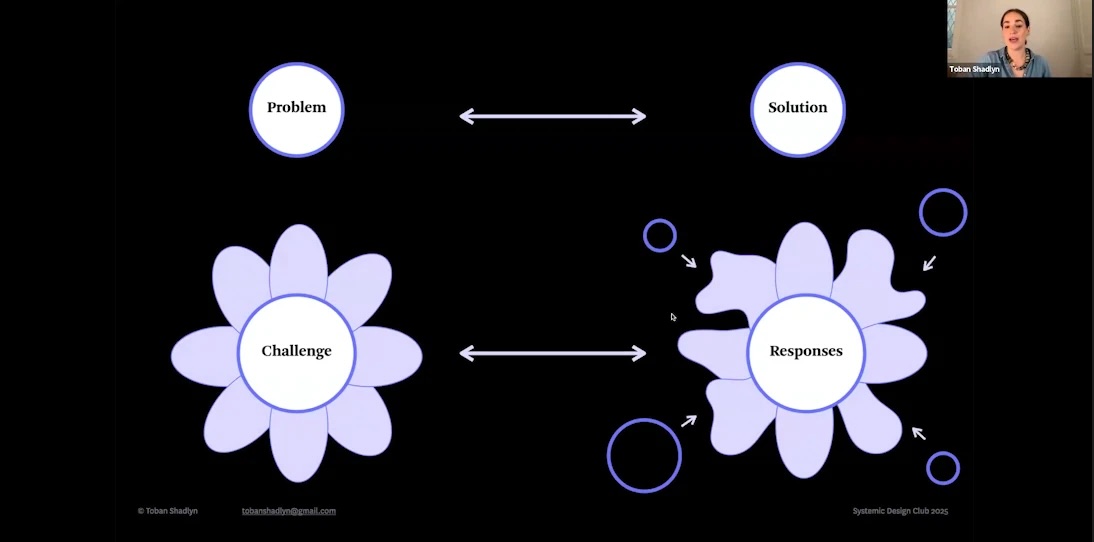
On the premise that the issues continue to work together and move dynamically, we will cooperate with a wide range of ecosystems to incorporate multiple perspectives, multiple methods, and multiple time axes into strategies and actions. It is necessary to acquire such different abilities as before, personally, organizationally, and collectively.
"A portfolio approach can be said to be a collection of interventions that work together to deliver strategic results. Those interventions are an important factor that enables the transformation of reality towards a desirable future. The portfolio defines the overall image to intervene and creates changes across multiple layers and multiple time axes.”
Changes that begin with "re-looking at the past"
Toban emphasizes the importance of "understanding the past" before making change.
It is not only the visible system that drives the structure of society. Behind it is the mental models (frameworks of thinking) that we naturally believe in. What kind of mental models do we have to recognize the issue? Toban argues that in order to address many of the systemic challenges, it is necessary to re-examine our mental models, to assess if they are serving us or not. And if not, to update them.
"Before you can imagine and start designing the future, it is essential to understand the logic and culture of the past. What have we inherited and what do we need to let go of? Before we move forward into the future, we need to change direction and look back on the past.

Futures Cones diagram projected forward and backwards
In addition, Toban emphasizes that looking to the past—at histories and lineages—is a vital way to think about a portfolio of interventions. Humans often focus their energy on ‘starting something new’ or ‘launching new initiatives’, but it is equally important to consider where our interventions sit within transitions. Some may play a role in winding down or hospicing existing narratives, behaviors, or organizations. This approach calls for awareness of multiple perspectives and time scales.
 The Berkana Two Loops Model. Diagram from Commonland.
The Berkana Two Loops Model. Diagram from Commonland. Practice in Rhode Island: Rewriting the "story" of drug use
Toban introduced the drug overdose countermeasure project in Rhode Island, USA – work she was involved in for years –as an example of practicing a portfolio approach.
Historically, in the United States, drug use was considered a "personal moral defect", and as a result of this narrative, a system was created that deemed drug use a crimial matter. The resulting policies (such as the “War on Drugs”) have cast a long shadow over society, leading to the unjust detention and disproportionate incarceration of people of color.
To develop a deeper understanding of this reality, Toban and her team participated in local events and public meetings for months, building relationships with people from various positions, including medical professionals, people who use drugs, researchers, policymakers, and local community-based organizations.
The goal was not to propose or develop "an immediate solution", but to understand “the readiness of the ecosystem”, in other words how and if Rhode Island was ready to engage with change. As her team continued dialogues and small experiments in the state, relationships were strengthened and activities spread like a snowball.
Little by little, there has been a change among people from the view that "drug use = defect" to the understanding that "it is just a part of the nature of human beings". Treat dependence as a "health and welfare issue" rather than a "crime". These changes of perspective were the beginning of a new story.
From these changes, various projects have been created in Rhode Island, such as creating a manifesto to depict the "future of caring medicine", passing new legislation making safe injection sites legal, to opening the first state snactioned one in December 2024.

How Overdose Prevention Sites Work exhibition, developed in collaboration with Toban’s team at RISD Center for Complexity, Brown Public Health researchers, and community-based harm reduction group RICARES. This exhibition invited the public to experience what exactly a safe injection facility is and does. This travelled around Rhode Island and Massachusetts, eventually leading to legislation reform.
Toban emphasizes that these processes were never planned from the start and were not linear. It is not something that can be clearly defined as it was only realized because her team remained involved, and that it is important.
"As you can imagine, it is very difficult to track and measure the results and effects of all this work. I can't say for certain that ‘we did this...and that's why this happened’. It may be similar to a loose correlation. ‘We did a lot of things with a lot of people, and the situation began to change.’”
Cultivate change with "time"
From the venue, "How do you get funds for activities that do not have such a definition of results and a specific path?" There was also a question.
Toban introduced the case of the Swedish government's innovation agency Vinnova as a unique example. Vinnova’s mission is to promote innovation and growth. In such an environment, Vinnova itself practices a mission-driven approach similar to the portfolio approach, and plays a role in involving different stakeholders, coordinating interventions, and setting the first spark.

Images from Vinnova’s Designing Missions Handbook.
On the other hand, in Toban's own project, it began with a collaboration with a company that shares the desire to do something about the challenges of drug overdose, and as the activities gradually expanded, various sources of funding such as national sources were accessed.
"As we spend more time in that space, as we become more active, as we meet more people and organizations, as time goes by, there is more room to think about how we can raise money for these efforts."
And what Toban emphasized in this lecture in particular was the perspective of how to incorporate "time" into the process. Social change takes 10 or 20 years (or longer). It is said that it is important to assume its long-term nature in advance and to find funders and colleagues who align with it.
"We aim to create a "place" for change, not an immediate "result"."
To end
Finally, Toban presented three questions about making a change: 1) Role, 2) Resource, 3) Time.
While going back and forth between these three, "what kind of role to play", "how to secure resources", and "what kind of time axis to proceed". It is said that continuing to ask about it is the key to making systemic changes a reality.
Until I heard Toban's story, it seemed that the first thing to do in the practice of the portfolio approach was to prepare plans and conditions, such as involving stakeholders in a wide area and broadly identifying intervention measures, but this lecture, what I saw through it was rather the opposite.
First of all, create a small but specific output, and stack the hitting moves according to the situation. It is the accumulation of such steady practice that grows the germ of change.
Take your time, carefully, and sometimes muddy. While dancing together on the "dancing terrain", we create the necessary changes. There, both flexibility as an attitude and the way the funds and ecosystems that support it are required. It was a time to be deeply encouraged by Toban's straightforward practice.
Editorial Notes
Due to time limitations, I want to add some additional context about the U.S. opioid crisis. My remarks didn’t fully capture the accuracy of how the current wave began. In the 1990s, pharmaceutical companies aggressively promoted pain medications and pressured medical professionals to prescribe them. These drugs proved to be highly addictive. Once the medical field recognized the extent of this addiction risk, doctors began reducing prescriptions—but by then, many people were already dependent, leading some to seek opioids through illicit sources.
Index